Fern
Schizaea pectinata (L.) Sw.
Family:
Common names: curly grass-fern; cockscomb fern, toothbrush fern (Eng.); grasvaring (Afr.)
Plant Attributes:
Plant Type:
SA Distribution:
Soil type:
Flowering season:
PH:
Flower colour:
Aspect:
Gardening skill:
Special Features:
Horticultural zones
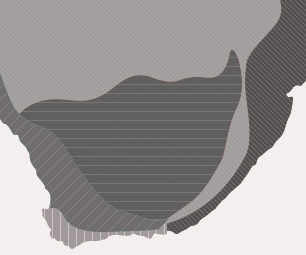
Alsophila dregei (Kunze) R.M.Tryon (synonym Cyathea dregei Kunze)
Family:
Common names: grassland tree fern, common tree fern, (Eng.); grasveldboomvaring, gewone boomvaring, (Afr.); isihihi (Xho.); isikhomakhoma, umphanga (Zul.)
SA Tree No: 1
Plant Attributes:
Plant Type:
SA Distribution:
Soil type:
Flowering season:
PH:
Flower colour:
Aspect:
Gardening skill:
Special Features:
Horticultural zones

Pyrrosia schimperiana (Mett. ex Kuhn) Alston
Family:
Common names: canyon fern (Eng.); afgrondvaring (Afr.)
Plant Attributes:
Plant Type:
SA Distribution:
Soil type:
Flowering season:
PH:
Flower colour:
Aspect:
Gardening skill:
Special Features:
Horticultural zones

Pyrrosia Mirb.
Family:
Common names: felt ferns
Species
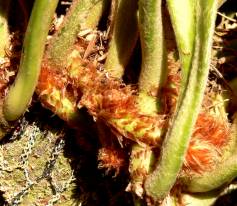
Pyrrosia africana is restricted to the eastern coastal regions of South Africa, extending northwards to southern Mozambique. The specific epithet is therefore somewhat misleading as it suggests the species occurs widely in Africa. Although the species mostly occurs as a low to medium high epiphyte in seasonally moist evergreen coastal forests, it often extends to the KwaZulu-Natal midlands, occurring at an elevation of approximately 700 m. The species also grows on rocks in forests. Pyrrosia africana has a rhizome up to 4 mm in diameter with fronds arranged dorsally on it. The short phyllopodia to which the fronds are attached, are up to 25 mm apart. The rhizome grows on the surface of the growing medium and is initially closely set with reddish brown scales, but soon becomes bare.

The small round sori, up to 2 mm in diameter, occur closely on the upper half of the fronds.
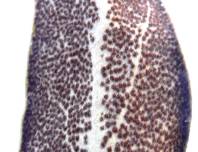
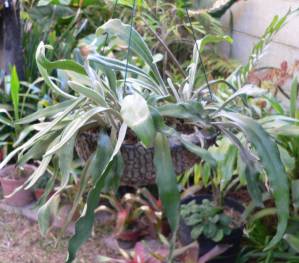
Pyrrosia schimperiana var. schimperiana is widely distributed in the tropical parts of Africa, occurring from West Africa to Ethiopia and southwards to Angola and Zimbabwe. The species has a restricted distribution in South Africa and is confined to the Blyde River Canyon and Mariepskop in Mpumalanga. Although the species also occurs as a low-level epiphyte, it often occurs in rock crevices on exposed and shaded cliffs, but never in deep shade. This species is named after the Strasbourg Professor of Botany, W.P. Schimper (1804-1878), who collected plants in various parts of Africa, particularly Ethiopia.
The rhizome of P. schimperiana grows up to 2 mm in diameter and is also not as widely creeping as that of the former species. The fronds are borne up to 10 mm apart and are firmly herbaceous, but not as leathery as that of the former species.
Both frond surfaces of this species remain densely covered by stellate hairs, giving the plant a greyish colour. The fronds grow up to 180 x 25 mm. The fronds of both species are poikilohydrous (frond turgidity varies in accordance with the available habitat moisture: fronds will roll up when dry and unfold when moisture levels increase).
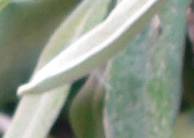
Plant Attributes:
Plant Type:
SA Distribution:
Soil type:
Flowering season:
PH:
Flower colour:
Aspect:
Gardening skill:
Special Features:
Horticultural zones

Polystichum Roth
Family:
Common names: shield ferns
Species
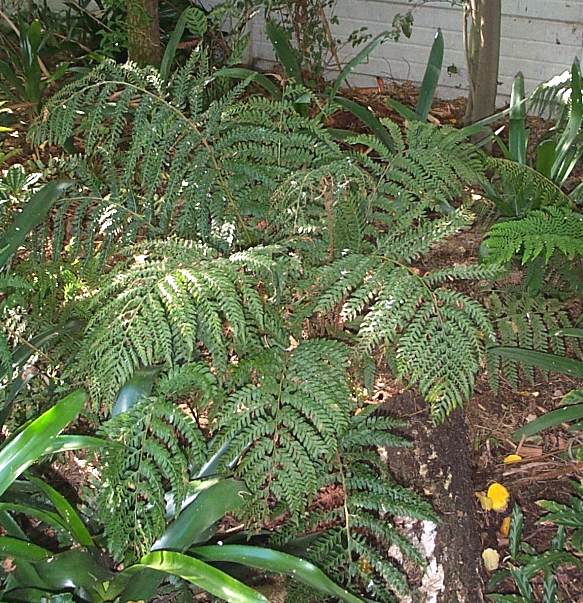
Polystichum incongruum: forest shield fern (Eng.); woud skildvaring (Afr.)
This species is confined to the Western and Eastern Cape in South Africa, occurring at elevations ranging between 600 and 1 350 m. Although it mostly occur in forests, it is not confined to them, often forming large stands on road cuttings. As a result of the decumbent and branched rhizome, the species has a shrub-like growth form, reaching a height of up to 0.8 m. The leathery dark green, erect to arching leaves may reach a length of up to 1.8 m, and can be up to 3 times divided. The species is best cultivated in moist, shaded conditions, although it will tolerate some sun once it is well established and the growing medium is kept adequately irrigated. Propagation is best done by rhizome division.
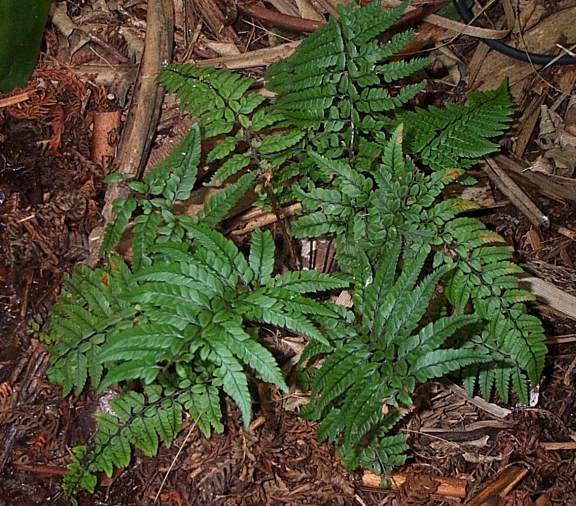
Polystichum luctuosum: mourning shield fern (Eng.); treur skildvaring (Afr.)
The species has a wide distribution in the Old World, extending as far as Japan. It is also widely distributed in South Africa, occurring from the Eastern Cape through KwaZulu-Natal to the north-eastern parts of the Free State, Mpumalanga and the Northern Province. It grows at elevations ranging between 760 and 1 740 m. The species is confined to evergreen forests where it grows on the forest floor or on rocks. P. luctuosum is often sold as P. tsus-simense and is a predominantly single-stemmed species resulting in a tussock-like growth. It can reach a height of up to 0.4 m. This smaller species has a very neat appearance, and is characterised by the almost black scales and dark veins, which contrast with the olive-green leaves. It is best cultivated in shade and needs to be kept moist, but not wet, at all times. It is a slow grower. Propagate by spores.
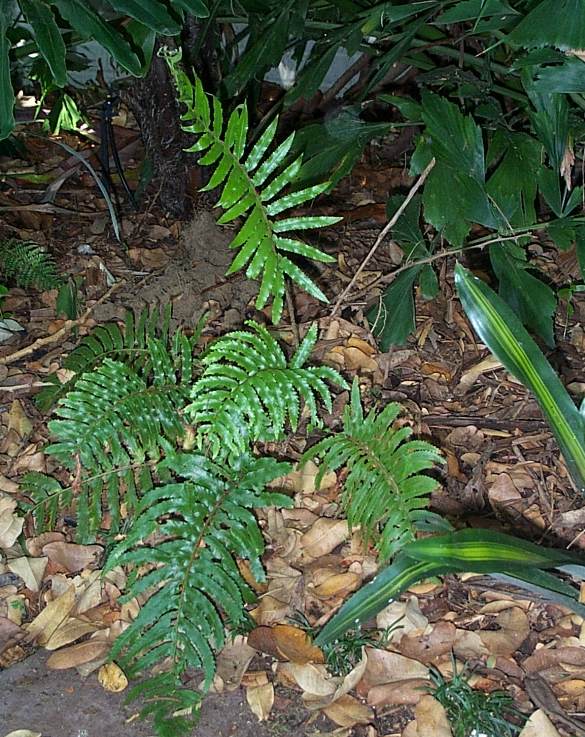
Polystichum macleae: McLea's shield fern (Eng.); oostelike skildvaring (Afr.)
Polystichum macleae is confined to the Drakensberg Escarpment and Wolkberg in Mpumalanga, occurring at elevations ranging between 1 350 and 1 960 m. It usually occurs in evergreen forests, but at higher elevations it is also found in the lee of large boulders. As a result of the decumbent, sparsely branched rhizome, it often forms small clonal stands resulting in a shrubby growth form. This is the only South African species with 1-pinnate leaves. They are mid- to dark green and can grow up to 1.5 m long. This very attractive species is worthy of cultivation. The species is best cultivated in light shade and requires permanently moist conditions. Propagate by rhizome division.
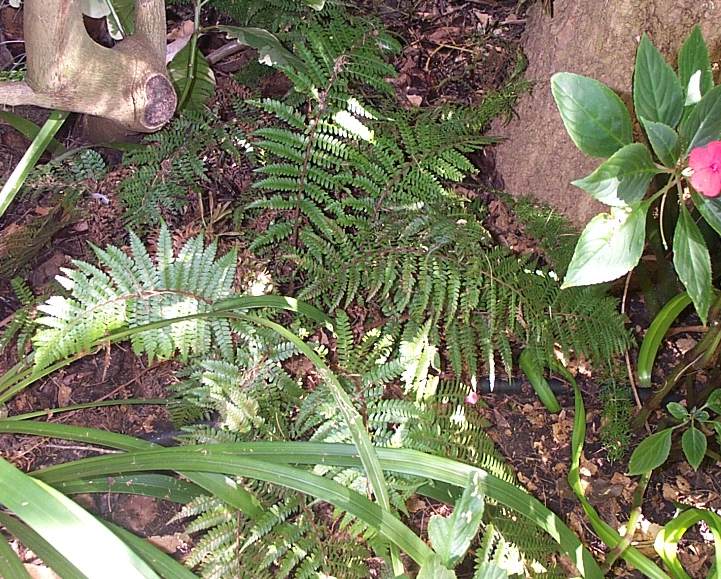
Polystichum monticola: mountain shieldfern (Eng.); berg skildvaring (Afr.)
Polystichum monticola is confined to South Africa, extending from the Kamiesberg in the Northern Cape, through the Western and Eastern Cape, KwaZulu-Natal and the Free State, to Lesotho, occurring from 600 to 2 740 m. The habitat includes seasonally moist, evergreen forests, rock crevices, cliff bases, stream banks, and forest margins, often growing in exposed, seasonally xeric conditions. The rhizome is decumbent and closely branched, resulting in plants forming a shrubby growth form. This variable and predominantly high altitude species is ideally suited for garden cultivation. The arching leaves are mid-green in colour and up to 0.8 m long. Although the species will tolerate some sun once well established, it is best cultivated in moist conditions in light shade. The species is slow-growing, and propagation is best done by rhizome division.

Polystichum pungens: forest shield fern (Eng.); woud skildvaring (Afr.)
Polystichum pungens is restricted to South Africa and Swaziland. In this region it ranges from Table Mountain, along the southern mountain ranges, and the Drakensberg foothills to the Wolkberg in Mpumalanga. It occurs at elevations ranging from 600 to 1 350 m and is restricted to forests. The rhizome is decumbent and regularly branched, resulting in the plants forming clonal stands and a shrubby growth form. The leathery leaves can be up to 1 m long, are dark green, and suberect to arching. The species is best cultivated in moist shaded conditions, but will tolerate morning sun once well established. Propagate by rhizome division.
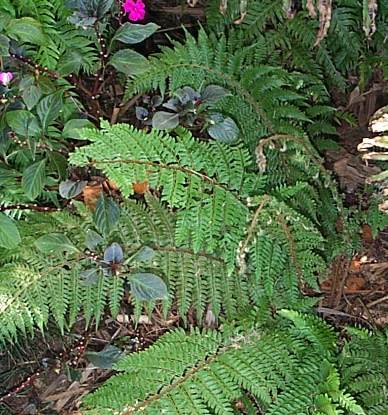
Polystichum transvaalense: stemmed shieldfern (Eng.); enkelstam skildvaring (Afr.)
Polystichum transvaalense is widely distributed in temperate and tropical Africa. In South Africa it occurs from the Drakensberg foothills in the Eastern Cape along the KwaZulu-Natal Drakensberg escarpment, the Eastern Cape and southern KwaZulu-Natal midlands, the Free State/KwaZulu-Natal and Mpumalanga/Limpopo Province escarpment to the Soutpansberg, with outlying populations in the southern Cape mountains. It occurs at altitudes ranging from 365 to 1 840 m and is confined to forests. It has a short, erect, usually unbranched rhizome and a tussock-like growth form. In suitable conditions the suberect to arching pale- to mid-green leaves may be up to 1 m long. The species is suited to be used as a focal point in smaller gardens and should best be cultivated in light shade, preferring moist conditions. The species is worthy of cultivation because of its neat appearance. Propagate from spores.
Plant Attributes:
Plant Type:
SA Distribution:
Soil type:
Flowering season:
PH:
Flower colour:
Aspect:
Gardening skill:
Special Features:
Horticultural zones

Pellaea calomelanos (Sw.) Link
Family:
Common names: hard fern (Eng.); inkomankomo (isiZulu); lehorometso (Sotho); legogoana (Tswana)
Plant Attributes:
Plant Type:
SA Distribution:
Soil type:
Flowering season:
PH:
Flower colour:
Aspect:
Gardening skill:
Special Features:
Horticultural zones

Osmunda regalis L.
Family:
Common names: royal fern (Eng.); adelvaring (Afr.)
Plant Attributes:
Plant Type:
SA Distribution:
Soil type:
Flowering season:
PH:
Flower colour:
Aspect:
Gardening skill:
Special Features:
Horticultural zones

Microsorum Link
Family:
Common names: wart ferns
Species
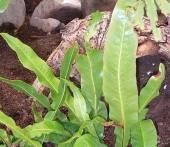
Microsorum pappei (Mett. ex Kuhn) Ching - Pappe's wart fern
The species is named after K.W.L. Pappe, the first colonial botanist at the Cape. The species is rare throughout its distribution, occurring from Madagascar to Tanzania, Mozambique, Zimbabwe and South Africa. In South Africa it is known from only a very restricted area in the KwaZulu-Natal midlands occurring in upland, moist, evergreen forests at about 750 mm above sea level. See more info below.
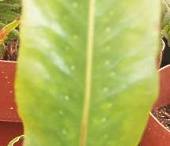
Microsorum pappei (Mett. ex Kuhn) Ching - Pappe's wart fern
Microsorum pappei has a widely creeping rhizome up to 3 mm in diameter with fronds spaced about 30 mm apart. The leaf stalk grows up to 120 mm long, and the glabrous, simple, narrowly elliptic lamina is up to 370 x 80 mm. The circular sori are 1.5 to 2.5 mm in diameter, and occur half-way between the midrib and the margin in one or two rows on either side of the costa.
The species is not available in the trade, but should it become available, it must be grown in light to deep shade in an environment with a high humidity. The species should be grown in a loose, well-drained medium that should always be kept moist.
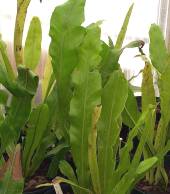
Microsorum punctatum (L.) Copel.-pitted wart fern
The specific epithet punctatum refers to the minutely pitted or dotted nature of the lamina.
Microsorum punctatum is widespread in the Old World, occurring from the Pacific islands, Malesia, tropical Asia and southern China to India , Madagascar and Africa. In Africa it occurs from West Africa through central to tropical East Africa to the east coast of South Africa as far south as Port St Johns. It is a predominantly low-altitude species occurring from near sea level to 1 500 m. The species rarely occurs on the ground, but more frequently in leaf litter and mosses on rocks in the forks of trees, often high above the ground. See more info below.
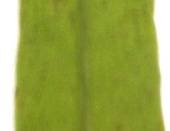
Microsorum punctatum (L.) Copel.-pitted wart fern
Microsorum punctatum has a short, creeping rhizome up to 4 mm in diameter and is covered with a thick felt of roots. The fronds are short-stalked and up to 10 mm apart. The narrowly elliptic lamina is simple, and up to 1500 x 110 mm. It has a thin leathery texture and is minutely pitted. The sori are about 1 mm in diameter and are irregularly scattered on the undersurface of the lamina.
The species is ideal for cultivation indoors and outdoors provided that it is planted in deep shade, never exposed to direct sunlight and kept moist at all times. An increased humidity will be beneficial. The species is best cultivated in a well-drained humus-rich medium kept moist at all times.
Uses: A tea of the plant is drunk for coughing fits. The leaf sap has also been reported to be used as an enema.
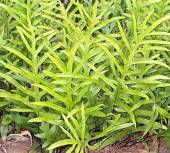
Microsorum scolopendria (Burm.f.) Copel.-embossed fern
The specific epithet scolopendria refers to the scalloped nature of the lamina.
Microsorum scolopendria , formerly known as Phymatodes scolopendria, is widespread in the Old World, occurring from Australia , throughout Polynesia and Asia and extending to Madagascar and Africa. In Africa it occurs from West Africa, throughout tropical Africa to the east coast of South Africa as far south as Port St Johns. In South Africa it mostly occurs in dune forests and dune scrub, near sea level. See more info below.
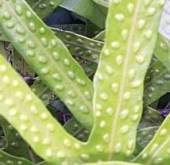
Microsorum scolopendria (Burm.f.) Copel.-embossed fern
Microsorum scolopendria has a widely creeping rhizome up to 10 mm in diameter that mostly occurs on the soil surface. The deeply pinnatifid, leathery fronds, up to 0.9 m long, are widely spaced along the rhizome. The stipe (leaf stalk) is up to 400 mm long. The leaf blade is divided into narrowly oblong lobes, up to 220 x 30 mm. The somewhat sunken sori are round to oval, 2 to 3 mm in diameter and occur in one or two rows on either side of the costa. Adaxially the sori are embossed.
This is a hardy species and easy to cultivate in a wide range of habitats. It is best cultivated outdoors in light shade, but it will also tolerate direct sunlight for part of the day. In older gardens it often establishes on brick or stone walls, or on trees, especially palms. Although it will tolerate short, dry spells it is best cultivated in conditions which remain constantly moist.
Uses: For abscesses, a paste of ground leaves mixed with earth from a wasp's nest is applied. For wounds, leaf pulp is used as a dressing, and for insanity, leaves are ground in water and the liquid drunk.
Plant Attributes:
Plant Type:
SA Distribution:
Soil type:
Flowering season:
PH:
Flower colour:
Aspect:
Gardening skill:
Special Features:
Horticultural zones

Family: Dryopteridaceae Class: Filicopsida Order: Polypodiales
Family:
Common names: wood fern family
Plant Attributes:
Plant Type:
SA Distribution:
Soil type:
Flowering season:
PH:
Flower colour:
Aspect:
Gardening skill:
Special Features:
Horticultural zones

Blechnum tabulare (Thunb)
Family:
Common names: mountain deer fern, mountain blechnum, false tree fern (Eng.); valsboomvaring (Afr.)
Plant Attributes:
Plant Type:
SA Distribution:
Soil type:
Flowering season:
PH:
Flower colour:
Aspect:
Gardening skill:
Special Features:
Horticultural zones






Rate this article
Article well written and informative
Rate this plant
Is this an interesting plant?
Login to add your Comment
Back to topNot registered yet? Click here to register.